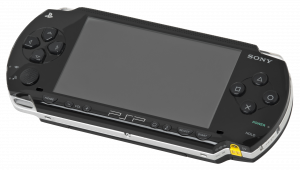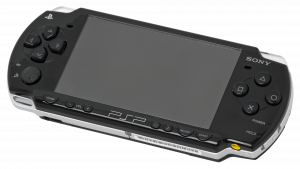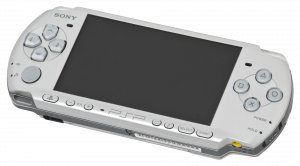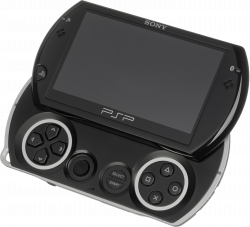PSP Model Differences
Page content & researching collaboratively taken from io55.net's PSP page with permission.
There are five PSP models with a variety of revisions within each model.
Retail Models
Models are arranged chronologically.
PSP-1000 "Phat/Fat" (2004-2007)
Part of the 01g generation.
The first PSP SKU ever released, often given the nickname of "fat" or "phat" due to it being the thickest and heaviest model. It can be identified by the power port's yellow area having contacts for a charging dock, the text next to the power LED being green, the speakers being towards the bottom of the console, a more flush fitting screen glass on the faceplate, a headset jack under the handstrap mount, and a thicker rear shell with heavier weight.
The batteries for the PSP-1000 featured 1800 mAh and 2200 mAh SKUs, but the Slim batteries for the PSP-2000/3000 series can be used on the 1000 series as well. Unlike future PSP SKUs, the PSP-1000 series only has 32 MB of RAM and no options for video output. Since it has 32 MB of RAM, it means loading games off UMDs will be slower while some homebrew plugins/applications will either be limited in functionality or won't work at all.
All of the stock LCD panels in this SKU (except TA-086 consoles) have the worst color accuracy and the slowest response times compared to newer SKUs, resulting in ghosting with any motion on screen and overall poor picture quality. This does vary depending on the LCD panel model, which is detailed in the motherboard revisions below. However, the mediocre stock screens can also be upgraded with IPS displays with vastly improved picture quality, rivaling the screen quality of the later PSP SKUs, and even the PCH-2000 series PS Vita. IPS upgraded screens are currently exclusive to this model.
Aside from the infrared port and slightly better ergonomics, the PSP-1000 generally has the least hardware features compared to the newer SKUs. Conversely, it does have the upside of being able to use old kernel mode homebrew designed for firmware 1.50 if necessary. It also has the advantage of every single motherboard revision having the ability to flash battery EEPROMs, which is useful for creating JigKick Batteries. However, flashing EEPROMs of Slim batteries on a PSP-1000 is a harder process compared to TA-085v1 PSPs.
TA-079
Official code name: "First"
This is the first motherboard revision found in the PSP-1000 series, with four minor revisions. The first two versions are the Japanese exclusive launch models, whereas the third version is the one first released in North America. The fourth and fifth versions were included on the launch consoles for the United Kingdom and Europe respectively. Consoles with the last version (V5) also had a revised Wi-Fi card. All PSP-1000 consoles with this motherboard series (except the last version, V5) come with unreliable Wi-Fi cards compared to future revisions. When a console's Wi-Fi card is dead, the PSP will display a 80410A0B error code when attempting to connect to a network. All TA-079 consoles also come with the worst quality screens compared to all newer models, but the last V4 and V5 models reportedly have improved screens compared to the V1/V2/V3.
If you are searching for a PSP-1000, avoid TA-079 consoles unless you can confirm it is a V5. This can be done by the viewing the manufacturing date, date code, or the output given out by pspIdent. If you are buying a TA-079 console from a PAL country, then seeing an older V1/V2/V3 console will be extremely unlikely due to them not being officially released in PAL regions.
TA-081
Official code name: "First"
The TA-081 was the next motherboard revision on the PSP-1000 series. It has one minor revision. The changes compared to the TA-079 were minor, but consoles with this board did address quality control issues on the TA-079 units. These consisted of shipping higher quality displays with less defects, fixing fragile Memory Stick covers, and including more reliable Wi-Fi cards. In terms of firmware and exploits, they can use the same programs that are compatible on the TA-079.
TA-082
Official code name: "Legolas1"
This is the third major PSP-1000 motherboard revision, which made far more notable changes compared to the TA-081. The console hardware was similar (aside from slightly worse screen quality compared to TA-081 consoles), but made several firmware changes to prevent methods of firmware downgrading. However, it is still possible to downgrade to 1.50 on these models using slightly different methods. If the console ends up having a corrupt IDStorage, a user can use homebrew apps like KeyCleaner to fix them.
TA-086
Official code name: "Legolas2"
The TA-086 is the final motherboard version for the PSP-1000, despite being named a higher number than the initial PSP-2000 motherboards. It is only a minor update to the TA-082, thus all the software changes from the TA-082 also apply to these models. However, it is notable for having the highest quality screen compared to other PSP-1000 models. Screens that come with these models are very similar to the PSP-2000 screens but with the ribbon cables for a PSP-1000.
PSP-2000 "Slim" (2007-2008)
Part of the 02g generation. Official code name: "Frodo" (all motherboards)
Sony's first retail successor to the PSP-1000 series. It can be identified by the power port's yellow area being a perfect circle without the charging dock pins, the presence of a serial number barcode on the bottom, and headset port being shifted to the very bottom of the system while having extra video output pins.
Compared to the original model, the PSP-2000 is slimmer, lighter (thus giving it the nickname "Slim"), doubles the RAM to 64MB, has a better screen than most PSP-1000's with more color accuracy and faster reponse times, and has external video output. Since external video output on the PSP-2000/3000 series is part of the headset jack, the older propritary headsets for the PSP-1000 are not compatible on PSP-2000 or 3000.
Since the PSP-2000 was made to be slimmer and lighter, the battery capacity was also reduced to 1200 mAh on these models. While this seems like a downgrade, Sony also revised the PSP-2000 motherboards to have higher power efficiency, so the battery life between a PSP-2000 with a 1200 mAh battery and PSP-1000 with an 1800 mAh battery are roughly the same.
PSP-2000 consoles can also use the larger batteries for the PSP-1000, but only without the stock cover. There are third party battery covers that support extended batteries on Slim PSPs.
Every PSP-2000 is also compatible with Pandora's Battery, but only consoles with TA-085v1 motherboards can write the EEPROM of Phat and (some) Slim Batteries to convert them into JigKick batteries.
TA-085
First Version
The initial motherboard revision for the PSP-2000. The first versions of this motherboard had similar security from the TA-082/86 on the original PSP, but booting 1.50 firmware requires a much different process. They also support flashing battery EEPROMs, but unlike PSP-1000s the TA-085 consoles can also flash (some) Slim batteries.
Second Version
The second version of the TA-085 is similar to the first one, but the ability to flash battery EEPROMs has been patched. However, they are still compatible with Pandora's Battery. Homebrew compatability is the same.
TA-088
The TA-088 was the third series of motherboard on the PSP-2000, with three versions. The first version has similar security to the TA-085v2, but the second version attempted to patch Pandora's Battery. Homebrew MMSes ended up being updated to circumvent the patches on TA-088v2, and Pandora's Battery still works. However, on TA-088v3 consoles, there were further patches to try remove custom IPL (initial program loader) exploits. This resulted in old the style of cIPL Custom Firmware and Memory Stick software for Pandora's Battery not being compatible for a long time. Classic JigKick battery support ended up being ported to the models anyway, due to newer Magic Memory Software like DDCv9. With ARK-4 custom firmware, there is also a method of true cIPL custom firmware without needing a tool like Infinity.
TA-090 (first version)
This is the last motherboard revision for the PSP-2000. Curiously, it is part of the same series as the early motherboards used for the PSP-3000 but still has the same security as the TA-088v2.
PSP-3000 "Slim & Lite" or "Brite" (2008-2014)
Part of the 03g, 04g, 07g, and 09g generations. Official code name is "Samwise" for 03g consoles, and "Samwise VA2" for all later generations.
Sony's third version of the PSP, and the last UMD model which also included Wi-Fi and external video output. Identified by the bottom row's buttons being ovals instead of half-circles, a small microphone near the “PSP” logo, and the “HOME” button (bottom left) being changed to a PlayStation logo. On the 3000, the most notable changes are the aforementioned addition of a microphone and button changes, the improvement of the video-out port (more output modes), and more importantly, an improved screen which comes with an issue which may bother some users.
To be more specific about the screen, the PSP-3000's screen has greater color range, superior contrast, superior pixel response, higher brightness, and less glare compared to the PSP-2000. However, it introduces a somewhat noticeable "scanline"-like effect which wasn't present on the 1000 and 2000. This is caused by the screen on the console having horizontially oriented subpixels rather than vertically oriented ones. While it is technically visible on the older PSP models (especially when they are rotated sideways), it tends to be less noticiable due to the them having much slower response time and worse contrast than the 3000's LCD panel. Essentially, the 3000's screen beats the 2000 in all ways except its distracting "scanline" effect. Otherwise, the PSP-3000 is very similar to the 2000 in terms of the form factor, button quality, having 64 MB of RAM, and so on.
The batteries are also the same between the 2000 and 3000, except for Monster Hunter 3rd special editions of the PSP-3000. These versions of the PSP-3000 are very unique, as they have a similar rear panel design to the PSP-1000. Thus, they also compatible with the larger 1800 mAh& 2200 mAh batteries from the original PSP with their stock battery cover.
The more notible differences between the 2000 and 3000 are in the hardware & firmware security. Due to the large amounts of exploits being discovered on the 1000 and 2000 models, Sony significantly locked down the security on the 3000 models. Before the modern exploits, running homebrew was also done with homebrew enablers, and cold boot CFW was first enabled with perma patches on 6.20 firmware, and later Infinity. However, methods to circumvent the newer security for Unofficial JigKick hardware, Magic Memory Sticks, and cIPL Custom Firmware have been defeated with modern exploits and software.
Revisions
The motherboard revisions for the PSP-3000 consist of the TA-090 series (second/third versions; 03g), TA-092 series (03g), TA-093 series (two versions; 04g), and TA-095 series (four versions; 09g for v1/v2 and 07g for v3/v4).
An important note about the TA-095 series is that several of the internal parts were significantly redesigned, casuing incompatiblity with all older PSP 3000 motherboards. A major change was with the WiFi antenna, as instead of being an external piece hiding behing the console information sticker (just like the PSP-2000), it was instead integrated with the motherboard.
An interesting note about the PSP-3000 security is that all models after the 03g generation had even further increased security for authenticating JigKicks, likely due to Datel planning to release new JigKick batteries that could work with the PSP-3000. The batteries ended up never being released to the public, likely to avoid legal issues with Sony.
PSP-N1000 "Go" (2009-2011)
Part of the 05g generation. Official code names are "Strider" for TA-091 motherboards, and "Strider2" for the unreleased TA-094 motherbords. No motherboard sub revisions.
Radically changed from earlier PSP models, the PSP Go was certainly a one-of-a-kind for its time, despite its poor sales. Featuring a slide-out set of buttons similar to those keyboard phones, the complete lack of a UMD drive, a drastically reduced weight and size, 16 GB of eMMC storage, a proprietary charging port, and a very nice screen (Essentially a PSP-3000 in terms of picture quality but smaller, although it also has the horizontally oriented subpixels), it is safe to say it's very easy to identify a PSP Go.
Introduces Bluetooth to the PSP line, and can connect to a DualShock 3 controller using a PlayStation 3 or PC. Capable of video output through model specifc component cables or a now rare and expensive PSP-N340 dock. There may also be adapters to convert older PSP video cables to a PSP Go's USB port, but they seem to be uncommon. The video output features combined with the DS3 connection ability makes the Go essentially like Sony's version of a hybrid console.
The batteries for the PSP Go changed to be enclosed in the console (in addition to putting a warranty sticker on the battery connector!), making them not as hot swappable. They are also lower capacity than the older PSP models (930 mAh instead of 1200 mAh). Due to the design of the console and its new batteries, JigKick batteries from older models are obviously not compatible either. Instead, JigKicks on the PSP Go are accessed through the multi-use USB port.
Console security and homebrew support has historically been similar to the PSP-3000. True cIPL support wasn't possible until ARK-4, and there wasn't any unbricking software available until Aiseirigh and DC-ARK.
The PSP Go uses the smaller "M2" type of Memory Stick, rather than the Memory Stick Pro Duo of earlier PSPs. This means that upgrading the storage for a PSP Go is harder, due to M2 Memory Sticks being more uncommon while MicroSD adapters require placement inside the console (as they are just standard Memory Stick Pro Duo adapters but with an adapter that converts them to M2).
More importantly, the PSP Go can still be hacked like earlier models. The hacking methods are essentially the same as late revisions of the PSP-3000, with those methods being compatible with all models.
With the PSP Go having such a unique set of features and a very forward-thinking design, it comes as no surprise to learn that the Go is the most expensive of all PSP models on used markets.
PSP-E1000 "Street" (2011-2014)
Part of the 11g generation. Official code name: "Bilbo" (both motherboards; TA-096/97. No sub versions.)
The PSP Street was a budget-oriented model exclusive to the PAL countries, and was the last ever retail SKU for the PSP. It is easily identified by its sleek bottom bar which has no prominent physical buttons. It comes with a more cheaply built matte plastic shell, the removal of the mute and brightness buttons, a lower battery capacity than the 1000/2000/3000 models, a Memory Stick Pro Duo card reader, a single (but still decent sounding) mono speaker, and the complete lack of any Wi-Fi card.
Similarly to the PSP Go, the PSP Street batteries are not easily removable like the older UMD models. They also have a similar capacity to the PSP Go (950 mAh instead of 930 mAh). JigKicks are accessed through the mini USB port, like the PSP Go. The process for activating service mode is much different, however. Just like the PSP-3000 and Go, unbricking methods were also very limited until recently, with the introductions of Baryon Sweeper, Asreigh, and DC-ARK.
Stereo audio can be regained from the 3.5mm audio jack. It does not support propritary headsets from either the PSP-1000 or 2000/3000, as the extra data pins are gone.
The screen quality of the PSP Street is actually quite high; it rivals the PSP-3000, Go, and IPS upgrades for the PSP-1000 in terms of color accuracy and reponse time while not having "scanlines" like PSP-3000 or N1000. However, it has a major downside in that the viewing angles are far worse than the aformentioned models, due to its orientation of the VA panel.
The bottom bar of PS/home, volume, select and start buttons differ from the 1000, 2000 and 3000 models in that they are integrated into a self-adhesive ribbon and plastic facer. This ribbon is more cheaply constructed than the ones present in the 1000-3000 models, and is prone to a fault where the metal buttons inside the bottom bar can damage the trace of the ribbon, stopping the button from working. Replacements of this button ribbon are becoming increasingly difficult to source, with many Chinese part sellers noting it out of stock. It is suggested that the buttons are pressed gently to avoid damaging the ribbon.
Additionally, this ribbon cable has to be replaced very precisely into the socket on the motherboard. A common issue with not inserting the cable correctly is that one or more of the buttons will not work. Later E1000 models have a strong tape securing the ribbon, suggesting that Sony became aware of this issue.
Since the PSP Street was only offcially released in PAL countries, isn't found easily outside of those regions.
Region Information
References
https://en.wikipedia.org/wiki/PlayStation_Portable
https://www.reddit.com/r/PSP/comments/cyfuod/psp_lcd_comparison_and_some_stuff_about_the/
https://www.psdevwiki.com/psp/SKU_Models
https://www.psdevwiki.com/psp/Motherboards
https://www.retrododo.com/wp-content/uploads/2022/01/psp-1000-psp-2000.jpg
https://www.reddit.com/r/PSP/comments/8jz5lb/2000_vs_3000_which_is_better/
https://www.reddit.com/r/PSP/comments/ai10k1/which_psp_is_best_for_hacking/
https://www.reddit.com/r/PSP/comments/886ga9/is_there_an_all_around_best_psp_model/
https://www.statista.com/statistics/1029044/worldwide-sony-playstation-vita-unit-sales/




